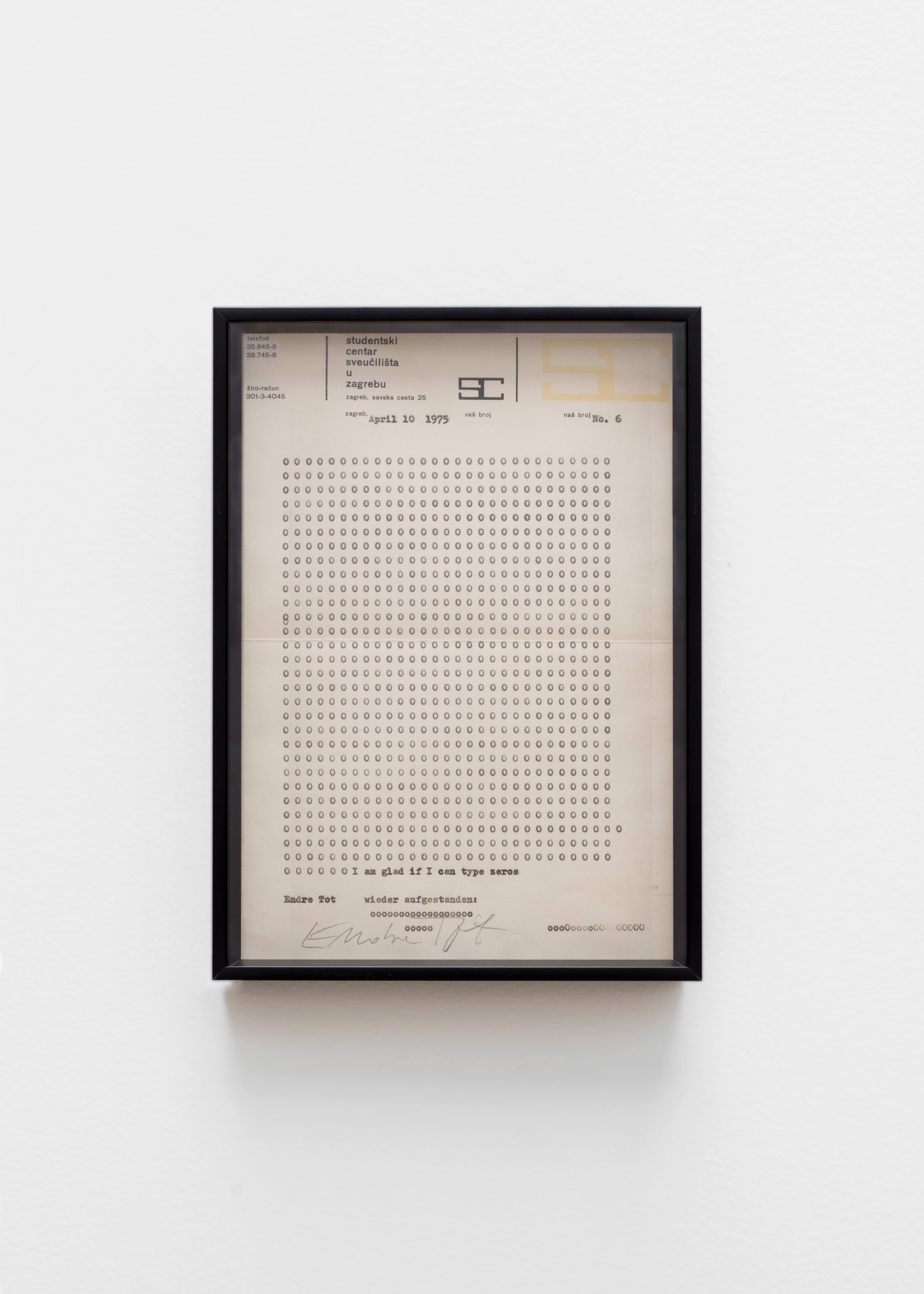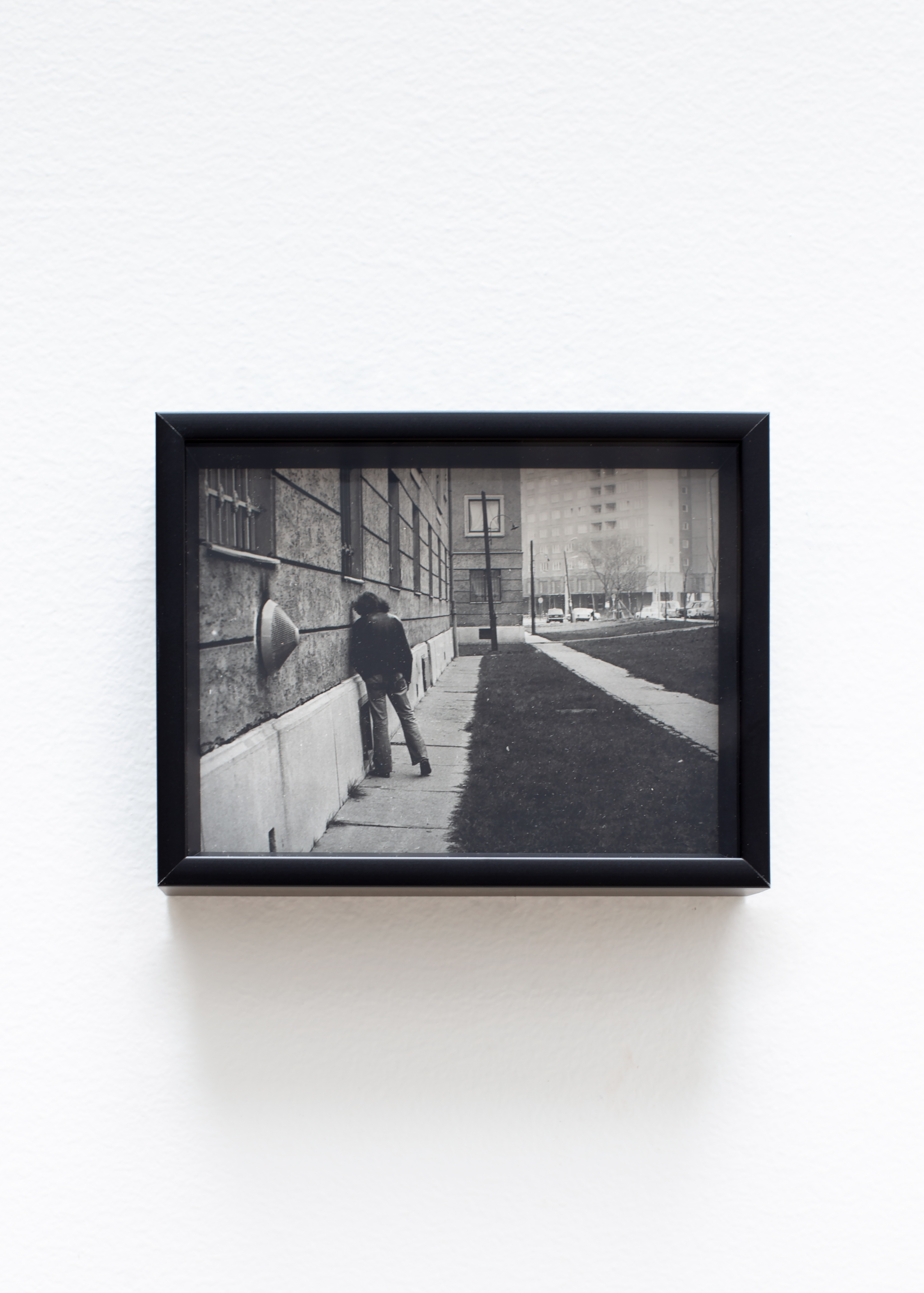I am glad if I am happy
Endre Tót, L21 in collaboration with acb gallery towards a borderline art: Endre Tót
Endre Tót (Sümeg, Hungary, 1937) has remained as a deeply mysterious and utterly transparent character during the preparations for this exhibition, which is also his first solo show in Spain.1 Tót began to develop an artistic practice increasingly close to the conceptualism that would come to characterise the rest of his career in the early 1970s, when his native country was under a strict communist regime. The iron curtain made it impossible for free and experimental art to flourish within its confines, but it could not isolate him completely from the vibrant international art scene of those years. It was perhaps this context of restricted freedoms that drove him towards a growing self-referentiality in his works, both from a philosophical and humorous approach.Paradigmatic examples of this are the letters filled with zeros that he typographed and sent by post and which would make him one of the pioneers of mail art. As well as later in time, the Zero Demo demonstrations organised in different cities in which the participants walked carrying banners with zeros on them. Even in a dictatorial regime in which censorship was a common practice, how to censor emptiness, which plays a fundamental role in Endre Tót’s works? From where could we approach communication reduced to its minimum expression?
I am glad if I can type zeros, can be read at the end of one of these letters that brim with numerical repetition and meaningful emptiness… if one looks long enough, only a perfectly geometrical grid can be seen from which a zero drops out, breaking the pattern and stepping into the margin of the page. There is an interesting parallel with a photograph from the same period, which portrays the artist gently pushing his body against the uniform façade of a building. As if he could be the personification of that undisciplined zero, doing what it did on the edge of the paper and disrupting with the presence of his body the geometrical patterns of a grey urban landscape.
Endre Tót blurs the boundaries between artistic practice and everyday life through such subtle actions that, if not for the photographic documentation of them, might well pass completely unnoticed like evanescent gestures, extra-artistic situations or events. In a series made up of an immense variety of this type of events that he gathers under the repeated title “I am glad…”, Tót carries out simple actions which in many cases can be interpreted as absurd on account of their self-referential nature: he turns his back to us while staring at a brick wall, takes a step with his right foot ready to land on the ground, stamps his ever-smiling self-portrait on a bare bottom, takes a photograph of his own shadow cast on the grass, draws a straight line on the façade of a building… all of them are minimal, barely noticeable gestures.
Nonetheless, as mentioned above, they are also aesthetic experiences delimited by its photographic documentation, which provides them with both a physicality, as a communicative medium, and a duration in time that extends beyond the temporality of the action itself. Delimitation is also a key concept in understanding Tót’s work, representative of an artistic practice that constantly deals with limits, whether they are geographical or disciplinary. In any case, and whatever their nature, they are pushed to make room for freedom and experimentation.
In this sense, the concept of borderline art, coined by George Brecht in the 1960s to delimit a set of practices that Lucy Lippard also called dematerialised and Lawrence Alloway non-compact, is revealing. Brecht was an artist with whom Endre Tót corresponded during this period, as he did with many other artists who formed part of the flexible, experimental and playful group that was Fluxus. His definition did not emphasise either the material or formal aspect in order to map this type of conceptual practices that appeared during the sixties and which had more to do with presence than with representation, but rather it focused on the experience of the limit itself. In Brecht’s words, it would be “an art at the point of imperceptibility. Sounds barely heard, sights barely distingushed (…) it should be possible to miss it completely.”2
Borderline art is therefore a type of practice that could become indistinguishable, though not totally indiscernible, from everyday life itself. The exhibition “I am glad if I am happy” brings together a series of minimal gestures and actions that have no hierarchical order. Making a geometric drawing with chalk, reading Lenin’s political theories and wagging one’s toe have the same experiential value here: the one given to them by an aesthetic perspective that has always tended towards creative experimentation and sense of humour and, harder still, has managed to remain unchanged over the decades.
In the most recent work in the exhibition, “I am glad if I don’t see you” (2001), Endre Tót stands with his face covered surrounded by one of those crowds of people so characteristic of German Christmas markets.3 Between his hands he holds a poster in which the same sentence that gives title to the work can be read in capital letters. In the foreground a man turns his head slightly to read the sentence while the artist remains somehow oblivious to the perceptual situation that his presence triggers… This character dressed in black continues to be the protagonist of actions that push us again and again to the experience of the edge or, more precisely, of a borderline art that tirelessly edges with life.

_ _ _ _ _ _ _ _ _ _ _ _ _ _ _ _ _ _ _ _ _ _ _ _ _ _ _ _ _ _ _ _ _ _ _ _
1. This exhibition is the result of a collaboration with acb Gallery.
2. George Brecth quoted by Dezeuze, Ana. In Search of the Insignificant. Street Work, Borderline Art and Dematerialisation. I. 18 Parvu (ed.), Objects in Progress. After the Dematerialisation of Art, Geneva, MetisPresses, 2012. Pages. 35-64. Page 39.
3. It is probably the Weihnachtsmarkt in Cologne, where the artist settled in 1980 and where he remains to this day.
Palma 2021



